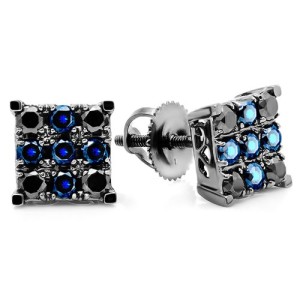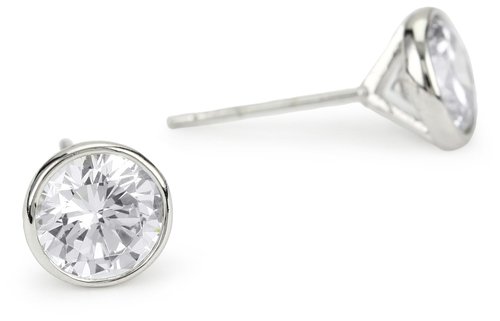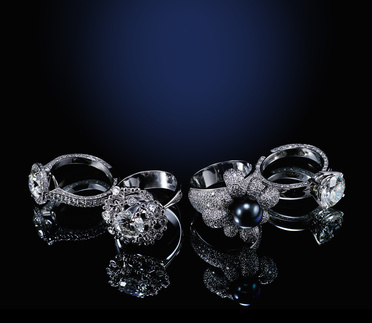Types of Settings for Diamond Studs
Diamond stud settings can be classified depending on how the stones in them are held and how the setting is shaped or styled.
Diamond Stud Settings According to How the Stones Are Held
The most common earring settings you are likely to see are made with either prongs or bezels:
Prong settings hold the diamond with 3 prongs or more (3 and 4 prongs are popular for diamond earrings).
This type of setting provides great visibility for the stone, but the fewer prongs there are, the less safe the mounting is, as the diamond is more exposed to damage and can also fall out more easily.
Bezel settings hold diamonds with a band of metal that surrounds the stone, fully or partially.
Click here to take a look at a collection of diamond studs.
This setting is safer than the prong setting, but some people find that bezels hide a greater portion of the diamond compared to prongs.
Diamond Stud Settings According to Style
In terms of shape, there are three most common types of earring settings, also referred to as styles:
Martini-style settings are shaped like a cone, and their V-shape resembles a martini glass when looked at from the side.
The diamond in this setting is set close to the ear, and as a result, the earring is less likely to droop.
Some people don’t like the conical shape of this setting, as they feel that it digs into their ear holes and stretches them.
Basket-style settings have a flat bottom, and the stones in many of them are set farther from the ear compared with martini-style settings.
This type of setting is a good choice if you are concerned that martini-style studs could dig into your ears.
Crown-style settings are also made with a flat bottom, but their construction is more solid, as they are made with more metal compared with basket-style and martini-style settings.
This, however, results in less visibility for the diamond. Stones in crown-style settings also sit farther from the ear, making the stud more likely to droop when put on.
Many online retailers offer the option to design your own diamond earrings – for example, check out the earring customization options here.
Metal Choices for Diamond Stud Settings
Diamond studs are usually made with white gold, yellow gold, or platinum. Let’s see what purposes each of these metals is most suitable for:
Yellow gold is relatively soft, and the higher its karat, the more easily the gold is to scratch and bend.
This metal is good for earrings that you will not wear every day. It is also a good choice for diamonds of lower color grades, as the yellow gold tends to mask the yellowish tints in such stones.
White gold is relatively more durable than yellow gold because white gold is covered with rhodium, which provides additional hardness and protection.
This material is good for earrings that you will wear more often and for diamonds that are colorless or nearly colorless, without visible tints.
Platinum is more durable than both yellow gold and white gold, and is one of the best choices for studs that you will wear every day due to its durability.
It is, however, more expensive than gold. Just like white gold, platinum is not suitable for diamonds with visible yellowish hues, as its white color will make them stand out.
Here you can design your own earrings by picking any of the above mentioned metals for the setting.
The Best Diamond Stud Settings
Now that you know what types of earring settings there are, let’s see which of them are best for different purposes:
Best setting for stone visibility and positioning: The martini-style earring setting is the best choice if you are looking for studs that will sit well on your ears, without drooping, especially if the stones are bigger.
It is also the setting that provides the most visibility for the diamond, and if you choose a model with prongs, they will leave more of the stone visible compared to bezels.
Best earring setting if you are looking for the lowest price: Regardless of style, a low-karat yellow gold setting made with prongs is the most affordable choice for diamond studs. (There are cheaper metals, but they are used less often in diamond jewelry.)
Yellow gold also allows you to pick cheaper stones, of a lower color grade, because the yellowish tints in them will not be as noticeable in the yellow metal.
Best diamond stud setting for durability: A platinum setting is one of the best choices if you are looking for durability, whether you are buying a martini, basket, or crown setting.
This metal can be scratched, but it wears down much more slowly compared with gold.
Best diamond earring setting for safety: If you are looking for a setting that will best protect your diamonds from accidental hits and will make them less likely to fall out of the mounting, go for a bezel setting. If safety is your priority, this is a better choice than a prong setting.
There are martini-style, basket-style, and crown-style settings that are made with bezels.
How to Choose Diamond Stud Earrings
Diamond Color for Earrings
Diamond color is graded using letters, with grade D being the highest, followed by E and F; all these grades indicate a colorless stone.
However, buying diamonds of such a high grade for stud earrings would be a waste of your money: The stones are small and will be viewed from such a distance that nobody would be able to make out whether their color is D/E/F or a lower grade such as G/H/I/J.
A diamond with a color in the H-J range will serve you just as well as stones with a better color – the difference will be invisible, but you will save yourself a good amount of money by not going with the absolutely top option.
Diamond Clarity for Earrings
Similar to color, diamond clarity is graded using letters, and just like choosing the best color won’t make a visible difference, opting for the top clarity grade over a slightly lesser alternative will cost you a lot but won’t yield a noticeable benefit.
That’s why it’s best to skip the diamonds graded FL (Flawless) and IF (Internally Flawless) and go for stones graded SI1 or SI2, whose flaws won’t be visible when the earrings are worn.
Keep in mind that diamonds in the same clarity grade may differ with respect to how visible their flaws are, and some SI2 stones may have noticeable inclusions. This is why you should take a good look at the studs you are about to buy and select diamonds that look clean when viewed with the naked eye, or just stick to SI1 and higher clarity.
And if the clarity of the stones is not graded, pick the cheapest ones that look reasonably clean from a normal viewing distance.
Click here to see a selection of diamond studs and their prices.
Diamond Cut for Earrings
The top cut grade according to the G.I.A. (Gemological Institute of America) is Excellent, followed by Very Good, Good, Fair, and Poor.
In general, the cut should be Excellent (or Ideal) in order to maximize the brilliance of the diamond.
Cut shape is a feature you should pay special attention to when selecting diamonds for your earrings.
Like cut, shape becomes more important the bigger and more visible a diamond is. But when it comes to earrings, you also have to make sure that their diamonds’ shape flatters your face.
In general, diamonds with rectangular shapes look best when complementing a broader face. Round and oval shapes are most suitable for thinner faces.
The round cut is especially suitable for a thinner face. The oval cut is very similar to the round cut, but earrings with oval stones give an additional impression of length.
The marquise cut looks very similar to the oval cut, but two of the ends of the marquise cut are pointed, enhancing the impression of length even more. It is important for these sharp points to be well protected by the earring setting, as they are very vulnerable to chipping.
The rectangular cuts include the princess cut, the emerald cut, the Asscher cut, the cushion cut, and the radiant cut. Depending on the length-to-width ratio of the particular cut, it can also look more or less square.
Like the round cut, the princess cut was designed to exhibit as much brilliance as possible.
The emerald cut is another good choice if you need a rectangular-shaped stone for your earrings. Keep in mind, though, that the emerald cut is not designed to maximize sparkle, so it will appear less brilliant than a princess-cut stone.
The trilliant cut, also called trillion cut, is the most commonly sold triangular diamond cut. This cut can come with either pointed or rounded ends. If you are buying trilliant cut studs with sharp ends, make sure they are well protected by the setting as they are very easy to break if hit harder.
Size of Diamonds in Earrings
The size of the diamonds in stud earrings is a matter of taste, but you should keep in mind that as stones get bigger, their flaws increase in number and become more noticeable, and any yellow tints in stones of a low-grade color will be more visible.
This is why you may need to pay extra attention to these quality characteristics if you are buying 1-carat diamonds, for example, and make sure they look clean and reasonably colorless.
Choosing Metal for Earrings
One of the factors to consider when choosing a metal for diamond earrings is durability. For example, yellow gold is softer than white gold, which is a better choice if you are looking for earrings whose parts will not bend or scratch easily.
An even better choice is platinum, but it is also much more expensive.
If you are set on gold, whether white or yellow, ask if the earrings contain nickel – not all people are allergic to it, but to be on the safe side, it is advisable to purchase jewelry with low nickel content (as in 14-karat or 18-karat gold) or no nickel at all.
You can also take into account clothing, hair color, and skin tone, and consider them when choosing the color of the metal. For example, yellow gold complements darker tones, whereas white metals are a better match for lighter tones.
Where to Buy Diamond Studs?
We recommend James Allen (read review) because you can take a 360-degree look at any stone before having it set in the studs of your choice.
Blue Nile is another reputable diamond retailer we recommend.



















